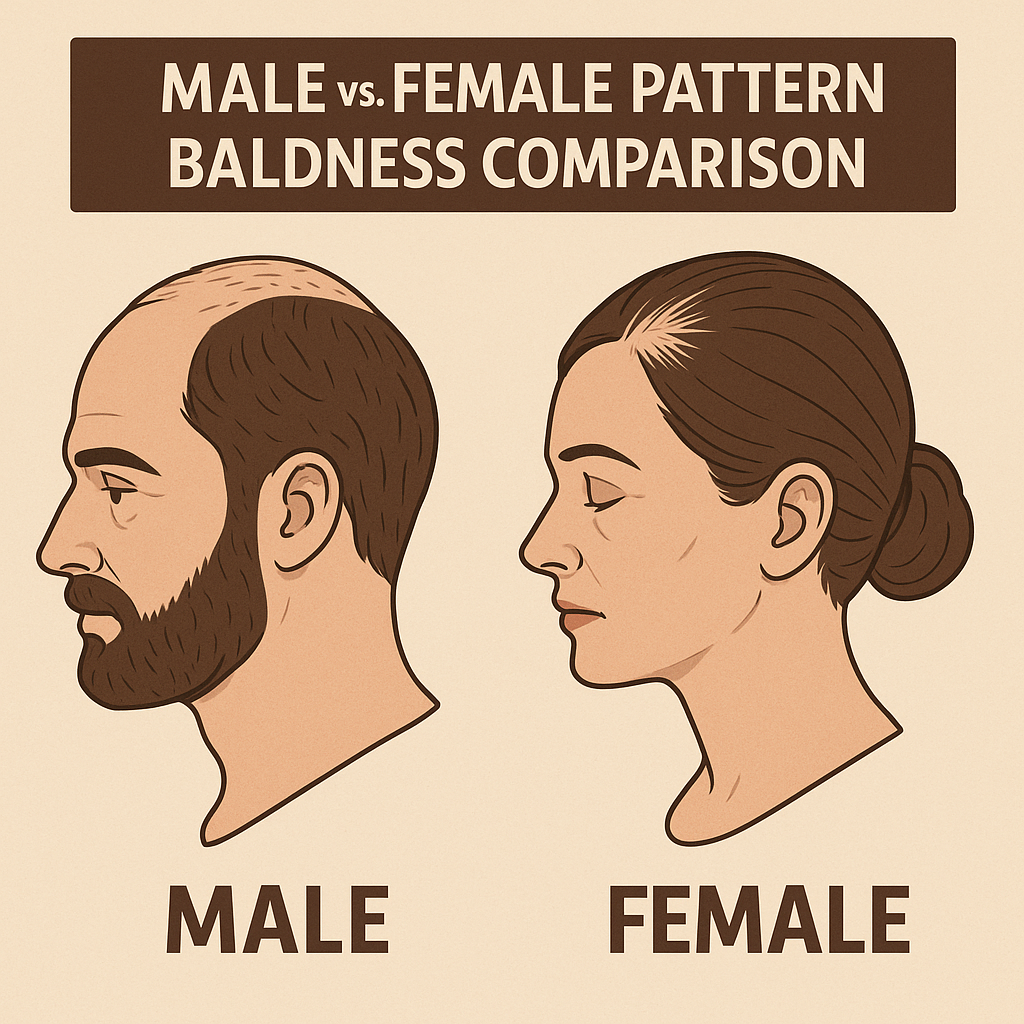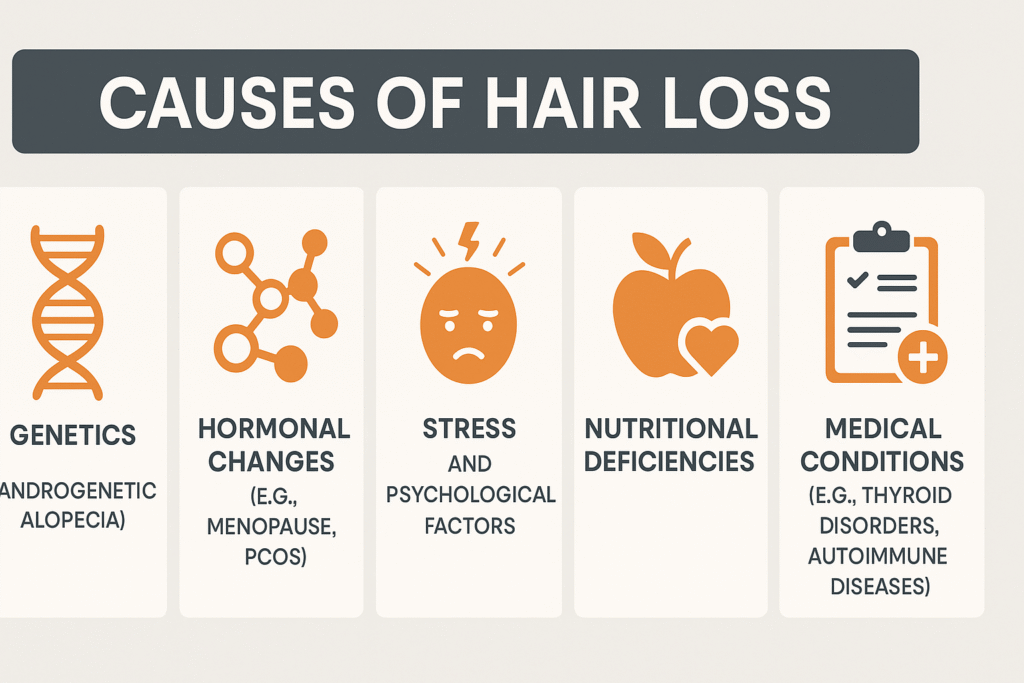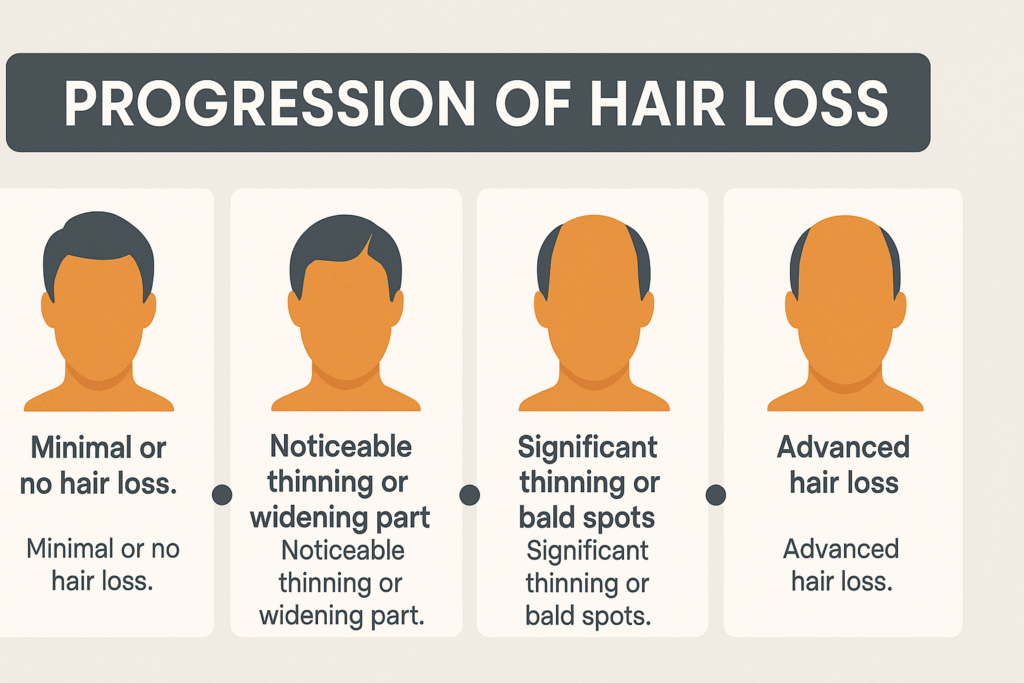Introduction
Imagine waking up one day to find more hair than usual on your pillow or noticing your hairline creeping back slowly but surely. Hair loss is a common concern that affects millions worldwide, regardless of gender. But have you ever wondered why men and women experience hair loss differently? Understanding the causes of hair loss, especially male vs. female pattern baldness, can help you take better care of your hair and even prevent further damage.
In this article, we’ll explore the science behind hair loss in men and women, dive into the root causes, discuss prevention methods, and highlight emerging solutions to keep your hair healthy and thriving.

What Is Pattern Baldness?
Pattern baldness, medically known as androgenetic alopecia, is the most common cause of hair loss in adults. It affects both men and women but manifests differently due to biological and hormonal variations.
- Male Pattern Baldness typically starts with a receding hairline and thinning at the crown, eventually progressing to bald patches.
- Female Pattern Baldness usually presents as diffuse thinning on the top of the scalp, often preserving the frontal hairline.

Causes of Hair Loss: Male vs. Female Pattern Baldness
The causes of hair loss are multifactorial, but androgenetic alopecia stands out as the primary driver.
1. Genetics and Hormones
- Genetic Predisposition: Both men and women inherit genes that can make hair follicles sensitive to hormones.
- Androgens: Hormones like dihydrotestosterone (DHT) play a key role in shrinking hair follicles, leading to shorter hair growth cycles and eventual hair loss.
Key Insight: In men, DHT binds to hair follicles more aggressively, causing distinct bald spots, while in women, fluctuating hormone levels often cause overall thinning.
2. Age and Hair Growth Cycle
As people age, hair follicles gradually shrink and produce thinner, shorter hairs. The natural anagen (growth) phase shortens, while the telogen (resting) phase lengthens.
3. Lifestyle and Environmental Factors
- Nutrition: Poor diet lacking essential vitamins and minerals like biotin, zinc, and iron can accelerate hair loss.
- Stress: Chronic stress elevates cortisol levels, which can trigger hair shedding.
- Pollution and UV Exposure: Environmental toxins may weaken hair follicles.
4. Medical Conditions and Medications
- Thyroid disorders, autoimmune diseases (e.g., alopecia areata), and scalp infections can cause hair loss.
- Certain medications (e.g., chemotherapy drugs, blood thinners) have hair loss as a side effect.
5. Female-Specific Causes
Women may experience hair loss due to hormonal changes during pregnancy, menopause, or conditions like polycystic ovary syndrome (PCOS).

Prevention of Hair Loss: Practical Tips
Preventing hair loss involves a combination of healthy habits, early intervention, and sometimes medical treatment.
1. Maintain a Balanced Diet
Nutrition plays a crucial role in hair health. Include foods rich in:
- Proteins: Hair is mostly keratin, a protein.
- Iron: Helps red blood cells carry oxygen to hair follicles.
- Omega-3 Fatty Acids: Nourish the scalp.
- Vitamins A, C, D, E and Biotin: Support hair growth and follicle strength.
2. Manage Stress Effectively
Techniques such as meditation, yoga, and regular exercise help lower stress hormones that contribute to hair loss.
3. Use Gentle Hair Care Practices
- Avoid harsh chemicals and excessive heat styling.
- Use mild shampoos with natural ingredients.
- Don’t over-brush or pull hair tightly.
4. Medical Treatments
- Minoxidil: An FDA-approved topical solution that promotes hair regrowth.
- Finasteride: Oral medication reducing DHT levels (primarily for men).
- Platelet-Rich Plasma (PRP): Injection therapy stimulating hair follicles.
- Hair Transplant Surgery: For advanced cases.
The Science Behind Hair Follicle Miniaturization
Hair follicle miniaturization refers to the process where hair follicles shrink over time, producing thinner and shorter hairs until growth stops. This process is triggered by DHT binding to androgen receptors in genetically sensitive follicles.
- In men, follicles on the scalp are more sensitive to DHT, causing the classic bald spots.
- In women, hormonal fluctuations may disrupt the hair growth cycle, but follicle miniaturization is often less patchy.
Nutrition and Its Role in Hair Loss Prevention
Scientific studies show a strong link between nutrition and hair health:
- A deficiency in iron is common among women with hair loss.
- Zinc supplementation has been found to reduce hair shedding.
- Vitamin D receptors influence hair follicle cycling.
- Protein-energy malnutrition slows hair growth.
Data Point: A study published in the Journal of Clinical and Aesthetic Dermatology found that 38% of hair loss patients had low ferritin levels (iron stores).
Here’s a structured comparison of various hair loss treatments:
| Category | Treatment | Effectiveness | Considerations |
|---|---|---|---|
| Medications | Minoxidil (Topical) | Moderate to High | Requires continuous use |
| Finasteride (Oral) | High | Potential side effects | |
| Therapies | Platelet-rich plasma (PRP) | Moderate | Involves multiple sessions |
| Low-level laser therapy | Moderate | Requires consistent use | |
| Surgical | Hair transplant procedures | High | Expensive, permanent solution |
| Lifestyle | Nutritional adjustments | Varies | Depends on individual deficiencies |
| Stress management | Varies | Helps prevent further loss |
Global Perspective: Advances and Challenges
Regions worldwide are witnessing a rise in hair loss cases due to lifestyle changes, pollution, and aging populations.
- Emerging markets are embracing natural and Ayurvedic treatments, blending tradition with modern science.
- Regulatory frameworks like GDPR in Europe and data privacy acts elsewhere ensure ethical use of personal health data in hair loss treatments.
- Awareness campaigns and affordable diagnostics are improving early detection and prevention globally.
FAQs: Causes of Hair Loss & Pattern Baldness
Q1: Is male pattern baldness inherited from the mother’s side?
A: Genetics from both parents can influence hair loss, though some studies emphasize the maternal line. However, inheritance is complex and not solely maternal.
Q2: Can stress alone cause permanent hair loss?
A: Stress typically causes temporary hair shedding called telogen effluvium, which usually reverses once stress is managed.
Q3: Are hair growth shampoos effective?
A: Some shampoos improve scalp health but don’t reverse genetic hair loss. Topical treatments like minoxidil are more effective.
Q4: How soon should one start treatment for pattern baldness?
A: Early intervention leads to better outcomes. Consult a dermatologist as soon as you notice excessive shedding or thinning.
Q5: Can diet changes stop hair loss completely?
A: Nutrition supports hair health but may not fully stop genetic hair loss. A combined approach is best.
Conclusion
Hair loss can be distressing, but understanding the causes of hair loss and how male and female pattern baldness differ empowers you to take control. Whether through lifestyle changes, nutrition, or medical options, prevention and treatment are within reach.
What are your thoughts on managing hair loss? Have you tried any prevention tips that worked? Share your story in the comments below!
References:
Ready to Stay Ahead? Bookmark our guide Technology and AI for updates!


